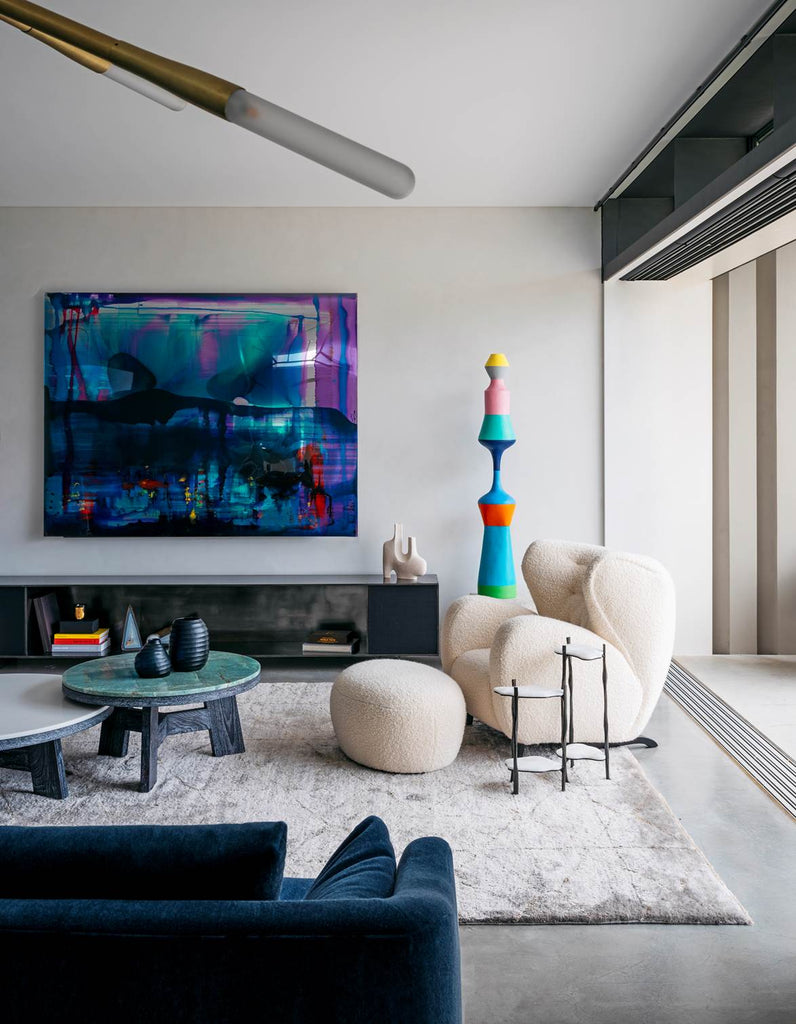Whether your choice of interior design aesthetic is Art Deco, Mid-Century or Period, contemporary living room ideas are always fun to consider and can inspire your decorating choices – even if you don’t class yourself as a ‘contemporary person’.
Herein lies the first question – what actually is contemporary design? What makes a space contemporary? And after that – what defines it? What are the ways that you can reference it in your own living room?
What is contemporary interior design?
Contemporary interiors are often thought of as being ultra minimal with an abundance of razor-sharp lines, graphic prints and high-shine materials and surfaces. It’s talked of as being dynamic and daring. It’s praised for pushing boundaries and its mastery of light and reflection. It’s criticised for being stark and clinical.
All of these points are certainly true of contemporary interiors, but there are more layers to it than that. It is a design movement reflective of the here and now, representing a breakaway from traditional decoration.
As you journey through the centuries of interior design styles and influences, from Neoclassical and Rococo to Mid-Century and Shaker, there’s a constant sway between ornamentation and bare, curves and straight lines, and ornate carvings versus geometric cut-outs. But ironically, these historical periods of design will have been contemporary at one point.
Contemporary design is about innovation and change that presents us with something fresh, different and, at times, disruptive from what we’ve seen before.

How to design a contemporary style living room?
A contemporary living room design can reach multiple aspects of your room. Or if you wish to create a more eclectic interior with just the occasional contemporary-style pieces, you can opt to bring it only one or two of-the-now references.
Remember though that a Modern living room is different to a contemporary one. Modern design is linked to the early 20th century and is much less fluid because it is affixed to a specific time. Modern is an umbrella term that covers what later became Mid-century and after that Post-modernism.
Each of the modern design movements has a clear identity, whereas contemporary design is constantly influx, borrowing inspiration from various eras of design and melding them into something new and exciting.
1. Use of colour
Colour – one of the most important areas for contemporary lounge ideas. It’s a common misconception that a contemporary scheme is all about bright white. Contemporary living rooms should actually have a stark contrast in the colours used, even if you’ve predominantly used white and there’s one key piece of furniture in the room that purposefully sticks out.
Monochrome is a favourite because it lets you move from one extreme to the other. Keep your colour choices confident and don’t be nervous about moving across the colour wheel. Contemporary colour palettes are strong and love to create interesting contradictions. That’s part of what makes them so dynamic.

2. Incorporate varied lines in your design
Another of the main associations with contemporary design is that lines should always be clean and crisp. It’s another story of contrast though. It’s the modern movements that put all their focus onto strong lines.
Contemporary style on the other hand prefers to mix the two. If you have a curvaceous ottoman and sofa set, bring in a modern art-style sculpture or an edgy pendant light that will command attention and provide diversity.

3. Contemporary style furniture
One of the commonalities in contemporary-style furniture is that the legs of sofas and armchairs are almost always on show. Tapered, angled wooden legs are preferred over traditional turned ones on castor feet or ones hidden under a skirt. Your surfaces and other furniture should mix exposed metals and glass with the occasional appearance from exposed wood.
Marble continues to reign supreme in contemporary interiors as much as in traditional ones, but here is where your lines should be uncomplicated. Smooth, strong, statuesque furniture in marble is the answer in a contemporary living room.
Be mindful that too many finishes and shapes can tip your room into being muddled. Contemporary design might favour a mixture of design influences, but eclectic can quickly become unfocused and confused.

4. Accent with metal
Metal in contemporary-style living rooms isn’t to be kept for tables and larger pieces of furniture alone.
Use metallic accents like hammered, polished steel on everything from photo frames and metal-trimmed trays to the edging of a floor length mirror or on oversized floor lamps.
Glossy brass on an exposed armchair’s frame, a gleaming gold vase or a cuff around a wall or clock are all steps to giving your living room a contemporary edge.
Greg Natale understands the power of metallic in this eastern Sydney project. Retro-inspired furniture trimmed with wide brass collar bases, metal mirror edging and unique metal decor complete the look

5. Add texture
Texture is one of the few laws of any room’s decorating scheme, regardless of the style you’re influenced by. Even if you were drawn to the less-is-more side of contemporary design, you’d still need to build layers of texture.
Texture can be as minimal or maximal as the rest of your decorating choices. Sleek and sophisticated metals, against supple leathers and matte, honed marble will give you three different but subtle textures to keep your mind interested and your eye active.
Texture isn’t all about what’s tactile either. You can achieve texture in your living room by combining colour and lighting too – anything that adds a visual stimuli and anything that plays with light.


